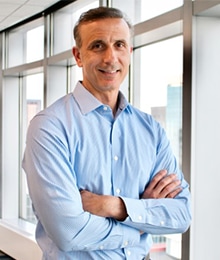Make Your Own Map:
How to set and achieve ambitious sustainability goals

Picture this: You’re standing at the entrance to a maze. You know what you hope to find at the end, but the path to get there is obscured.
This is a familiar feeling to many organizations and sustainability professionals as they figure out how to bring ambitious sustainability goals to life.
Even during the disruptive year 2020, companies have been making bold commitments around carbon, water, equity, operations and beyond. What can we do to ensure that we achieve these goals, particularly when their success can have such a dramatic impact on the health of our world?
I don’t have all the answers – nobody does – but I’d like to share how the Ecolab team is making our own map to get through the maze and reach our 2030 Impact Goals. Ultimately, it comes down to three key buckets:
- Aligning strategically with your business
- Picking the right partners
- Rallying internal teams
Walking you through Ecolab’s journey, I hope you will come away with ideas to enact sustainable progress within and outside your business.
Let’s get started:
Aligning strategically: Are you driving progress for both your organization and the world?
When we look ahead to the world 10 years from now, we know that we will face both challenges and opportunities.
Already, we’re experiencing issues around public health, climate change, water stress and supplying safe food to a growing population. But we know that we can work together to find solutions that are bigger than the problems, ensuring a promising future for everyone.
That’s why Ecolab launched our 2030 Impact Goals, which are focused on the change we can create for our company, communities, customers and planet.
In developing our 2030 Impact Goals, we had three objectives:
- To continue to find ways to integrate sustainability into a growth-oriented business model
- To amplify our positive impact on the planet
- To expand our focus to include environmental issues and social issues like public health, safe food, diversity, inclusion, equity and safety
For example, some of our 2030 goals focus on helping our customers:
Through our work for customers, by 2030, Ecolab aims to help industry:
- Conserve 300 billion gallons of water annually, equivalent to the annual drinking water needs of 1 billion people
- Become carbon neutral by reducing greenhouse gas emissions by 4.5 million metric tons, helping to prevent 7.3 million pollution-related illnesses
- Provide high-quality and safe food for 1.8 billion people, helping to prevent 11 million foodborne illnesses annually
- Clean 50 billion hands and provide safe medical care for 116 million people each year, helping to avoid 1.7 million infections annually
We knew from the beginning that to achieve these ambitious goals, we had to align them to our company’s future growth and ability to create value. We had to ask ourselves, does this grow our top line, support our brand purpose and lead to a positive impact in the world?
Identifying goals at the intersection of your organization’s strategic purpose and direction and current global challenges helps ensure they will be embedded into business operations going forward.
Picking the right partners: Are you collaborating with experts?
As I said earlier – I don’t have all the answers when it comes to creating the roadmap for our goals. Luckily, I don’t have to have all the answers at this stage; the method and solutions we use will likely continue to evolve as our world’s technology, research and information advances.
Our goals are aggressive, but we’re not alone. We know we’ll need to engage and collaborate with experts to execute our plan, which is why we will continue to actively pursue partnerships with organizations with expertise, insights and actions that complement our own.
An example of how this might look in real life: Our internal climate goals include a commitment to achieving 100% renewable electricity by 2030. So, we joined the RE100, a global initiative that brings together companies who share this commitment and are willing to exchange best practices and information.
Our internal water goals focus on achieving a positive water impact, is supported by our membership in the UN Global Water Compact’s Water Resilience Coalition, which brings together leading global brands to drive smart water management within their operations and communities.
Proactively engaging these groups can lead to true and ongoing partnership, as each party can help identify potential blind spots and/or opportunities for further collaboration.
Rallying internal teams: Do your employees see the success of these goals as their success?
Finally, you cannot reach your goals without the support of your internal teams. For both our customer-focused goals and our internal operational goals, the Ecolab team is absolutely essential. To make change in an organization, people need the tools to be successful and an understanding of why that success is imperative.
As we bring our teams into our 2030 Impact Goals, we’re focused on the following:
- Ensuring the goals are embedded into day-to-day operations by engaging influential leaders throughout all levels of the organization to educate and motivate their teams. Our leaders need to clearly explain how the daily work of our teams makes these goals possible, whether that’s our sales team bringing new customers on board or our research teams developing the solutions that will help us meet our customer goals.
- Setting clear and measurable objectives that are spaced out over time. By breaking the work down into bite-sized pieces, we can provide manageable checkpoints for people to work toward.
- Making a connection between the goals and our impact in the world. Our teams are motivated by our purpose to make a positive difference through our unique abilities, solutions and expertise, so the clearer the tie to that purpose, the easier it will be to explain the importance of a project.
The success of any project depends on a team working together and moving in the same direction. Bringing on the various key teams in your organization at the outset will set you up for success.
The strategies outlined above may not work for everyone. Each organization has its own mission to achieve, and that comes with unique challenges and opportunities. But ultimately, we’re all pursuing the same end state: sustainable, responsible practices that support the health of our organizations and future generations. As we set out on new projects, I look forward to learning from each other and charting our path together.



